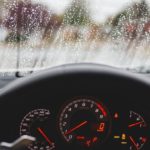Quick Navigation

Are you hearing a water sloshing sound in your car as you start, accelerate, turn, or stop? Worry not as it is normal. This sound occurs typically after rain. The sound is synonymous with cars with clogged AC drain lines, worn out the sunroof, a bad air cooling system, or a bad AC compressor.
No matter the cause of the water sloshing sound, you can rectify the issue and allow the car to run smoothly. If you’re unsure of the cause of water sloshing, take the car to a professional mechanic for a checkup.
Here are some of the causes of water sloshing in your car and how to handle them:
Water Sloshing From The Passenger Side Of The Car
The first section to look at when you hear water sloshing from your car is the passenger side. This is where the AC drain lines are located. The sound may become louder as you accelerate or decelerate the vehicle.
The sound comes typically about when it’s raining or after rain. This is because water accumulates in the AC ducts instead of draining. Here are some of the things that cause the water sloshing sound on the passenger side:
- Blocked drain holes – you may hear the sound if the drain holes are blocked. This is easier to detect as you can inspect the drain lines and see if the water is clogged. Simply clear the drain lines if there is any dirt or debris stuck inside.
- Drain holes are very high – some vehicles are poorly designed with a reservoir around the sunroof’s perimeter. This reservoir collects water when it rains, and the small drain holes cannot put up with the water. As a result, it gets clogged, and that’s why you hear the water sloshing sound when you drive. The water will be collected on the passenger side of the footwell. You will have to clear the drain pipes every time it rains. You wouldn’t want the water to stick around for long and cause more issues.
Water Sloshing During Start-up
The water sloshing sound varies from one car to another. In some vehicles, it may be during acceleration or while turning. In others, it may be when starting the car. So, what causes a sloshing sound when you start your car?
It is easier to detect a sloshing sound that occurs as a result of a bad heater core. Some of the signs include the water sloshing sound when you start the car. Other symptoms are a sweet smell in the cabin, foggy windows, high coolant use up, and lower coolant level.
These are indications that you need the mechanic to attend to your heater core. When your vehicle is parked, the coolant may leak, and once you start it up, you may hear a sloshing sound as the coolant moves around.
The heater core circulates the coolant through the little tubes and radiates heat into the cabin. Besides, it is also in charge of allowing the defroster to work well. Unlike other coolant system parts, the heater core is straightforward to maintain.
You don’t need to purchase a new heater core. However, you should inspect the hoses around and leaks. That’s why it is crucial to visit a mechanic for maintenance purposes.
Outdated Sunroof
This is one of the overlooked causes of car water sloshing. If you have old or worn-out sunroof seals, water will drain into the vehicle every time it rains. And as the water drains down to the drain holes, they may not handle all the water at once, which may cause clogging.
As a result, this will lead to a sloshing sound when you drive.
Inspect the seals and unclog the drain holes. If the sunroof seals are worn out, you should replace them with new ones.
Apart from the sunroof seals, you should also inspect the rear hatch. This component has multiple drains with a hatch seal. If the hatch seal is worn out, you need to change it.
Failure to do so will allow excess water, which will lead to clogging. Before installing a new hatch seal, make sure that all drains are thoroughly cleaned.

Water Sloshing When I Accelerate My Car
If you hear a sloshing sound when you accelerate your car, there is a chance that your air cooling system is not functioning properly. The sound usually is loud and irritating. If there is air in the cooling system, it goes into the heater core as it’s the highest point in the cooling system.
Once you accelerate, the water pump spins quicker, forcing the coolant into the heater core and pushing the air out. In the end, it produces a sloshing sound.
The good news is that you can get rid of air in the cooling system. All you need to do is to get the engine to the operating temperature. Next is to loosen up the top radiator hose neck with the engine in idle position.
Use a small flat-bladed screwdriver and slide it between the top radiator hose and the radiator hose neck. Finally, let the engine idle until all you see come out from the radiator hose is the coolant. You can then retighten the hose clamp.
Water Sloshing Around The Car (Rear, Back, Front)
It is common for water to slosh around the car after it has rained. It can be in the rear, back, or even in the front of the car. However, the sloshing shouldn’t be persistent after the rain is long gone.
If the sloshing sound continues, then there is a high chance that the drain holes in the bottom of the door are clogged. As a result, they cannot get rid of water within a specified period. If this water is not cleared in time, it may lead to other issues.
For instance, you may have foggy windows, which may be a safety challenge. Another thing that you may have to worry about is the mold developing in the car. This may deteriorate your car quickly than anticipated.
The front doors are designed to have water pass through them and drain at the bottom. But if this is not happening, then the drains on the bottom are clogged. Nonetheless, you can unclog the drains in a few easy steps:
Step 1: Start by conducting a rain simulation.
Step 2: Monitor drainage by lifting the seal at the bottom of the front door. In case water drains after lifting the door’s seal, then there is a chance that the holes are clogged. You will have to clean them.
Step 3: Next step is to identify all drain holes along the door.
Step 4: Clean both the front and backside of the door’s seal. You can apply a gentle spray of water behind the seal and into the drain to help in cleaning.
Step 5: Finally, try doing a rain simulation and check if drainage is fine now.
With these few steps, you can unblock your front door’s drainage holes and prevent rainwater from being trapped.
Under-filled Cooling System
Another instance that may result in a water sloshing sound is when your coolant is under-filled. However, this does not happen to all vehicle makes and models, but to only a select few.
It happens when you empty the cooling system and refills it. After refilling the coolant, getting rid of all the air pockets in the heater core can be a daunting task. This is because the heat core in most vehicles is as high as the radiator cap and at the reverse end of the system.
To get rid of the air in the heater core, you should park it on a steep surface with the front of the vehicle facing upwards. Next, you should run the engine with the radiator cap off. For better results, Squeeze the hoses and adjust the throttle.
Don’t squeeze any hose but focus on the hose near the back of the engine compartment to the heater core. You should see some bubbles coming up at the top of the radiator.
When the fluid levels fall, ensure to add some coolant and repeat the process until there are no more bubbles. Another indication of an under-filled coolant is when you get warm air instead of hot air.
A Bad Ac Compressor
Not all water sloshing sounds are linked to blocked drain holes in different parts of the car. A sloshing sound can also be due to a bad ac compressor. The AC compressor is one of the crucial parts of a vehicle’s air conditioning system.
It is in charge of pressurizing the AC system and keeping the refrigerant flowing so that it can work well. Just like any other car part, the AC compressor wears out after some time and needs changing.
One of the signs of a bad AC compressor is a sloshing sound. In some scenarios, you may hear a grinding sound, which is associated with leakage or worn-out bearing. If you find out that the noise is coming out because of a worn-out compressor, replace it.
It is normally advisable to replace the AC compressor rather than repairing it. Seek the services of a professional mechanic to avoid improper installation.
Conclusion
Now that you know why your car is producing a sloshing sound, you should get the issue fixed right away. We hope you’ve found this article informative and helped you in one way or another. All the best as you fix your car problems!

James has been a car enthusiast since his childhood when he learned the differences between a ford and a chevy from his father. He loves to drive and restore old cars with a special drive for Italian marvels. Currently, he has a 1968 Alfa Romeo. He has studied aeronautics and civil aviation in his college and still gets smitten by Galant SS and Lancer GSR.
He is a New York-based product training director working with a giant automotive retailer. He loves to review and uncover the vehicles and their fascinating stories. He believes in keeping it legitimate with a keen passion for research on the latest technological upgrades in cars. While reading his articles or blogs, you can sense the extensive research and dedication backing the piece of text. He loves fried chicken, music, and spending quality time with his pet dog.






